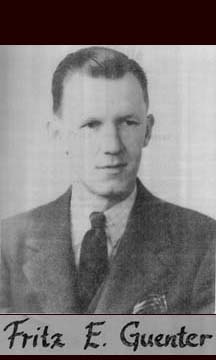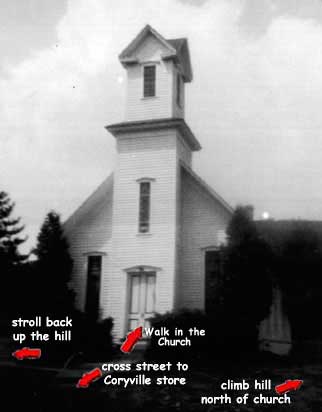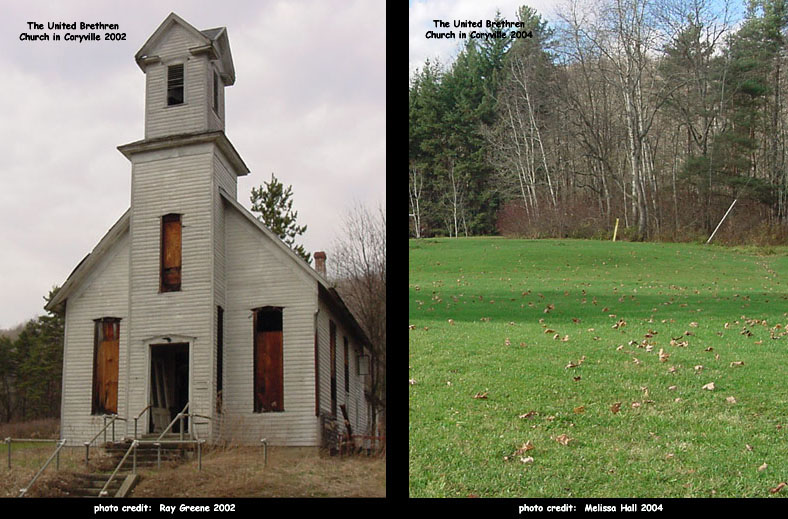|
Coryville Memories by Fritz
Edward Guenter 
1994 Guenter Siblings, INC. Clearfield p36-41
The church in Coryville was directly across
the road from the store, but up a bank so that you would have to
climb up some steps to reach it. While Mother and her sister were
growing up, you could look straight across from their second floor
porch into the front door.
The building was plain and free of decoration.
Later some stained glass windows were added, but early on a glazed,
opaque glass filled every window. A small entry under the bell tower
opened directly into the church. From a central aisle, simple pews
on both sides went down to a slightly
elevated stage at the back. A door at the extreme
left led back to a large room and small kitchen. The platform curved
back beside the door. There were small gates at the left side led
to the aforementioned door. There was a somewhat larger opening
directly in front at the end of the aisles, while a small gate on
the extreme right opened up to a piano on the stage. A heavy wooden
lectern held a large Bible in the middle. Everything was colored
light brown. There were gaslights down both sides and at the back
of the stage.
On Wednesday nights prayer meetings were held.
Thursday, all day, was Ladies A. The laidies of the church met in
the back room and made quilts, prepared a lunch for which there
was a small charge, and sn ocialized igeneral. My father and I went
there to eat many times when Mother was not home, and I remember
well that the food was delicious.
The prayer meetings were somewhat informal,
with people spontaneously praying aloud when they felt the mood.
At times, too, there was singing—someone would break into song and
others would join in. I especially remember BF doing this; I enjoyed
listening to his voice filling that church. Some gave testimony,
which was an oral description to temptation, sin, and the help of
prayer. I think for some this may have been an opening into the
limelight, for others a type of catharsis. One of our neighbors,
Mrs. Lemon, was apt to get somewhat carried away with her testimony.
After I rushed home to tell my family about the juicy details of
our neighbors’ transgressions, Mother gave me a long talk about
prayer and prayer meeting. My memory of the gist of it was: “Do
not pray for specific things; pray for strength to help you survive.”
I had gone to that meeting with my grandparents. I do not think
I went to many—if any—more.
My mother had been brought up in the tradition
of the United Brethren Church. The Cory family had donated
the land for the church and she had faithfully attended it all of
her life. She had attended Otterbein College, the church supported
school in Westerville, Ohio. With all this background, she still
managed to have sensible and reasonable relationship with the church.
Once, years later, after an unusually fundamental sermon, I asked
her how she could tolerate such talk. She said, “ I listen
and try and translate it into what they should be saying.”
My father had been brought up in the Lutheran
religion and never joined the church in Coryville. He did attend
regularly, taught Sunday school classes, and was even on the Board
of Directors. He did not care for the traveling evangelists, but
you would not know this from his attitude. Once, when he was older,
an evangelist kept the congregation standing for what seemed like
hours as he exhorted and railed for people “ to come forward and
be saved.” Dad had a painful knee, so after a time he quietly sat
down. The minister abruptly stopped and announced: “ In all my years
of service, that is the first time anyone has ever sat down on me!”
Dad quietly stood up, smiled gently, and walked out. In moments
others began to leave, and shortly the church was almost empty.
I would like to think that people wanted to support Dad and certainly
some did, but I suspect others just saw a good chance to get out!
The next morning a shaken minister and evangelist were at our house
early with all sorts of apologies. Dad gave them his gentle smile
but remained completely noncommittal.
I once had Dad for a Sunday school teacher.
He said an important thing to have in life was a “ stick-to-it-iveness.”
I do not know what Biblical texts he derived this from, but I understand
it crept into most of his lessons. Once I asked Tom Lemon, my neighbor
buddy, what he had learned in Sunday school that day. He said,
“oh, the same as usual…be good.” The Golden Rule was a recurrent
theme.
My family never really pressured me about religion,
and as I grew older I did not attend church that much. Briefly there
was some conflict about playing baseball on Sunday, but this was
resolved quickly after some discussion about where the emphasis
lay. Years later Mother was to say to me, “You know that through
all the ages of history religion has been a powerful force for good
in the world. It deserves your support.”
At Christmas the church served as a community
center. Christmas was celebrated at school with a program of songs,
recitations, tableaux, and some small exchange of gifts. The program,
such as it was, was repeated at the church Christmas celebration,
with added spiritual messages and a great deal of carol singing.
This was the setting in which families might exchange gifts, or
a boy might give the girl he loved a gift. Many of the people who
lived in the company houses we called “the chemical patch” were
catholic and some of the Irish were also catholic, but at Christmas
they came to the Coryville church. Some would stand in the back,
more would stand outside, and others would stand across the road
in front of the store, but all joined in the singing and laughed
and smiled as a decrepit Santa brought a very small bag of hard
candies to each child. There were almost no denominations on that
one night. My friend Eldred “Deacon” Gill was a good Irishman and
he told me that it was a sin for him to enter any other church.
“So,” he said, “I sin a little sometimes.”
Nowadays fundamentalist churches have a bad
image: greedy televangelists rake in the offerings; non-traditional
customs have replaced old practices. These churches have become
the laughing stock of the media. Yet I can remember much that was
sweet and simple and kind about the United Brethren. I remember
people of good character, strong men and women who worked hard and
practiced what their Bible taught them. And the music was a joy!
Even now, if I close my eyes and listen carefully, I can hear BF
leading us all:
I come to the garden alone,
While the dew is still on the roses,
And the Voice I hear,
Falling on my ear,
The Son of God discloses.
And He walks with me, and He talks
with me,
And He tells me I am His own,
And the joy we share as we tarry there,
None other has ever Know.
Another excerpt
from- Coryville Memories |


